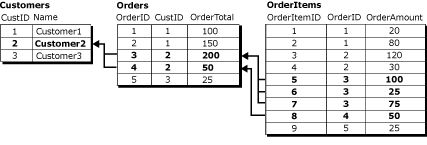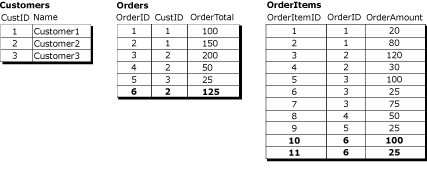Group Changes to Related Rows with Logical Records
Applies to:
SQL Server
Note
This feature will be removed in a future version of SQL Server. Avoid using this feature in new development work, and plan to modify applications that currently use this feature.
By default, merge replication processes data changes on a row-by-row basis. In many circumstances this is appropriate, but for some applications, it is essential that related rows be processed as a unit. The logical records feature of merge replication allows you to define a relationship between related rows in different tables so that the rows are processed as a unit.
Note
The logical records feature can be used alone or in conjunction with join filters. For more information about join filters, see Join Filters. To use logical records, the compatibility level of the publication must be at least 90RTM.
Consider these three related tables:

The Customers table is the parent table in this relationship and has a primary key column CustID. The Orders table has a primary key column OrderID, with a foreign key constraint on the CustID column that references the CustID column in the Customers table. Similarly, the OrderItems table has a primary key column OrderItemID, with a foreign key constraint on the OrderID column that references the OrderID column in the Orders table.
In this example, a logical record consists of all the rows in the Orders table that are related to a single CustID value and all of the rows in the OrderItems table that are related to those rows in the Orders table. This diagram shows all the rows in the three tables that are in the logical record for Customer2:

To define a logical record relationship between articles, see Define a Logical Record Relationship Between Merge Table Articles.
Benefits of Logical Records
The logical records feature has two primary benefits:
Application of data changes as a unit.
The detection and resolution of conflicts simultaneously on multiple rows from multiple tables.
The Application of Changes As a Unit
If merge processing is interrupted, such as in the case of a dropped connection, the partially completed set of related replicated changes is rolled back if logical records are used. For example, consider the case where a Subscriber adds a new order with OrderID = 6 and two new rows in the OrderItems table with OrderItemID = 10 and OrderItemID = 11 for OrderID = 6.

If the replication process is interrupted after the Orders row for OrderID = 6 is complete, but before the OrderItems 10 and 11 are completed, and logical records are not used, the OrderTotal value for OrderID = 6 will not be consistent with the sum of the OrderAmount values for the OrderItems rows. If logical records are used, the Orders row for OrderID = 6 is not committed until the related OrderItems changes are replicated.
In a different scenario, if logical records are used, and someone is querying tables when the merge process is applying changes, the user will not see the partially replicated changes until they are all complete. For example, the replication process has uploaded the Orders row for OrderID = 6, but a user queries the tables before the replication process has replicated the OrderItems rows, the OrderTotal value would not be the same as the sum of the OrderAmount values. If logical records are used, the Orders row would not be visible until the OrderItems rows are complete and the transaction has been committed as a unit.
The Application of Conflict Handling to More Than One Table
Consider the case where two Subscribers have the data set above:
A user at the first Subscriber changes the OrderAmount of OrderItemID 5 from 100 to 150 and the OrderTotal of OrderID 3 from 200 to 250.
A user at the second Subscriber changes the OrderAmount of OrderItemID 6 from 25 to 125 and the OrderTotal of OrderID 3 from 200 to 300.
If these changes are replicated without using logical records, the different OrderTotal values would result in a conflict and only one of them would be replicated. But the non-conflicting changes in the OrderItems table would be replicated without conflict, leaving the final OrderTotal values in an inconsistent state with respect to the OrderItems rows. If logical records are used in this scenario, the OrderItems change associated with the losing Orders table change would also be rolled back, and the final OrderTotal value would be an accurate summary of the OrderItems rows.
For more information about options related to conflict detection and resolution with logical records, see Detecting and Resolving Conflicts in Logical Records.
Considerations for Using Logical Records
Keep the following considerations in mind when using logical records.
General Considerations
It is recommended that you keep the number of tables in a logical record as low as possible; five tables or less is recommended.
Logical records cannot reference columns with any of the following data types:
varchar(max) and nvarchar(max)
varbinary(max)
text and ntext
image
XML
UDT
Foreign key relationships in published tables cannot be defined with the CASCADE option. For more information, see CREATE TABLE (Transact-SQL) and ALTER TABLE (Transact-SQL).
You cannot update any columns that are used in the logical relation clause.
Custom conflict resolution with business logic handlers or custom resolvers is not supported for articles that are included in a logical record.
If logical records are used in a publication that includes parameterized filters, you must initialize each Subscriber with a snapshot for its partition. If you initialize a Subscriber with another method, the Merge Agent will fail. For more information, see Snapshots for Merge Publications with Parameterized Filters.
Conflicts that involve logical records are not displayed in Conflict Viewer. To view information about these conflicts, use replication stored procedures. For more information, see View Conflict Information for Merge Publications (Replication Transact-SQL Programming).
Publication Settings
The publication must have a compatibility level of 90RTM or greater. For more information, see the "Publication Compatibility Level" section of Replication Backward Compatibility.
The publication must use native snapshot mode. This is the default unless you are replicating to SQL Server Compact, which does not support logical records.
The publication cannot allow Web synchronization. For more information about Web synchronization, see Web Synchronization for Merge Replication.
In order to use logical records on a filtered publication:
Precomputed partitions must also be used. The requirements of precomputed partitions also apply to logical records. For more information, see Optimize Parameterized Filter Performance with Precomputed Partitions.
You cannot use nonoverlapping parameterized filters. For more information, see the "Setting 'partition options'" section of Parameterized Row Filters.
If the publication uses join filters, the join unique key property must be set to true for all join filters that are involved in logical record relationships. For more information, see Join Filters.
Relationships Between Tables
Tables related through logical records must have a primary key-foreign key relationship.
The NOT FOR REPLICATION option cannot be set for foreign key constraints.
Child tables can have only one parent table.
For example, a database tracking classes and students might have a design similar to:

You cannot use a logical record to represent the three tables in this relationship, because the rows in ClassMembers are not associated with a single primary key row. The tables Classes and ClassMembers could still form a logical record, as could the tables ClassMembers and Students, but not all three.
The publication cannot contain circular join filter relationships.
Using the example with the tables Customers, Orders, and OrderItems, you could not use logical records if the Orders table also had a foreign key constraint that referenced the OrderItems table.
Performance implications of logical records
The logical record feature does come with a performance cost. If logical records are not used, the replication agent can process all of the changes for a given article at the same time, and because the changes are applied in a row-by-row fashion, the locking and transaction log requirements necessary for applying the changes are minimal.
If logical records are used, the Merge Agent must process the changes for each entire logical record together. This has an effect on the amount of time it takes the Merge Agent to replicate the rows. Additionally, because the agent opens a separate transaction for each logical record, locking requirements can increase.